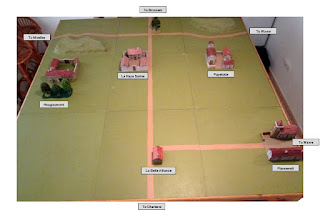Waterloo
wargame table
I have decided to attempt a game based on
Waterloo to trial whether the whole project will work or not. It is perhaps a little strange to game the
last, and one of the largest, of the Napoleonic battles, as the first of the
series.
There are two main reasons why I have done so.
First I know the battle so well that there is
very little research required.
Second if I can make it work for this one the
rest should be quite easy.
The table is very basic and does not attempt to
recreate the historical battlefield.
The roads are correct and the main buildings
and villages more or less so. I have
used buildings from our collection, so they do not look like the
originals. I have however put
Wellington’s tree on the cross roads!
Wellington has a ridge, of sorts, to help his deployment. The one on the left has the Nivelles road running behind it. The one on the right has the Wavre road running behind it. This is correct, but does not play a significant part in the wargame as it did in the actual battle.
Wellington has a ridge, of sorts, to help his deployment. The one on the left has the Nivelles road running behind it. The one on the right has the Wavre road running behind it. This is correct, but does not play a significant part in the wargame as it did in the actual battle.
Table at
start of wargame
I have not made any attempt to follow the
historical order of battle.
Wellington’s army is the standard one I use for the British/Portuguese
in my 1813 campaign. I have reduced
each corps from four to three infantry brigades. And the Portuguese brigade in each corps
becomes a Dutch/Belgian brigade. This
gives me 96 infantry, 16 cavalry and 16 gunners with 4 guns.
Napoleon commands the same army as he does in
the 1813 campaign, with one exception. The
Polish corps which forms part of his First French Army in the campaign, has
been replaced by the 2nd French corps. This is because I wanted all of the French
army to be French brigades. The four
corps are full strength. There are 128
infantry, 16 cavalry, 16 gunners and 4 guns.
So the French 32 more infantry than the
British.
Unlike my campaign games I have collected the
four cavalry brigades on each side into two corps and given each a
commander. I have also created a very
small “Grand Battery” for Napoleon by taking the artillery from the Guard and 4th
corps and putting it under the command of an ADC.
I have used the names of commanders from both
sides. This was easier for the French,
because they had corps during the battle.
More difficult for the British, because they had divisions.
I wanted Reille to command the attack on
Hougoumont, Lobau on La Haye Sainte and D’Erlon on what Jac Weller calls PHLS
and I call Papelotte. I also wanted
Cooke to command the right flank and Picton just east of the cross roads. I also wanted Ponsonby to command the
British heavy cavalry, even though I must be the only wargamer who does not
have Scots Greys.
This is all for colour, and to help me
recognise the game as similar to Waterloo.
In fact I am quite pleased with the visual look of the table.
The real test will come when we play the
wargame.
You will find more information here


